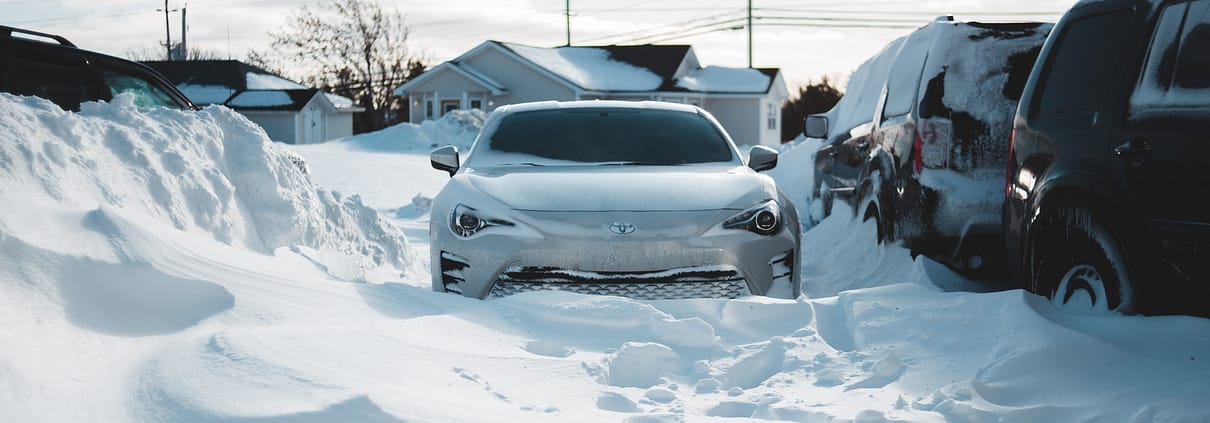What Does Winter Weather Do to Your Car’s Finish?
Nothing beats enjoying a long drive in summer weather. But while sitting in the sun and heat is relaxing and enjoyable, it can be difficult on your car’s paint, exterior trim, and tires. Did you know that winter weather can be just as harsh on your car’s finish, or even more so? It’s true – even without the extreme UV ratings and heat, your car’s exterior can be damaged in the cold, miserable weather.
Your personal pride takes a hit when your car doesn’t look as good as it used to. By understanding what damages your car’s exterior in the winter, you can help mitigate and correct it for a look you can be proud of. Here are four effects of driving in winter weather and how you can prevent or fix the issues.
The effects of moisture during temperature changes
If you’re in Canada or the northern US states, temperature fluctuations during the frigid winter months are vast. The mercury can change 30 C (54 F) in a 24-hour period, and that can change snow to water and vice versa, not to mention the moisture suspended in the air becomes extremely unpredictable. The variations in moisture and temperature might just seem like bizarre weather, but it’s harmful to your car’s exterior.
If any amount of moisture gets behind the paint or trim, expansion and contraction from freezing and thawing isn’t going to be pretty, figuratively and literally. Even a slight amount of moisture that penetrates under paint from, say, a scratch, can cause paint to lift and the steel underneath to corrode. It can separate trim from painted surfaces too.
Temperature and moisture changes are inevitable during the winter, but keeping your car free of ice and snow as much as possible is the right idea. And to prevent water intrusion under the paint, seal scratches.
Rust and corrosion from road treatments
Aggregates like road salt and sand are a necessity for gaining traction as you drive, but it’s almost unbelievable how harmful those elements can be to your car. Most drivers can identify which state or province a vehicle comes from simply by looking under the hood where deposits have corroded metal surfaces. Your car’s exterior is protected by a few layers of high-quality paint, but it isn’t impervious to damage from salt and sand. Deposits that stick to your paint can be corrosive, but the worst part is when you try to remove them.
If you were to compare your car’s lustre before the snow flies to the spring after thaw, odds are that you’ll notice it shines a little less afterward. Each grain of salt and sand is an aggregate that has sharp edges and leaves microscopic scratches. Over a few years, there’s a definite difference that’s visible to the naked eye that only polishing can correct.
It’s easier and better to protect your car from that damage in the first place. Whether it’s with a coat of high-quality wax or long-lasting ceramic coating, your car’s paint will look better for longer, even after a harsh winter.
Delamination from breaking away buildup
Have you been tempted to kick the blocks of snow off your rocker panels or wheel wells? Whether you’re guilty of the practice or not, it isn’t healthy for your car’s painted finish. The ice and snow that stick to your car adhere almost like concrete, which is why so much effort is required to knock them free. When you kick it off, it’s possible for little chunks of paint to come off as well.
Granted, some of the paint might already be flaking, but this practice in winter accelerates the damage to your car. The best idea? Find a warm garage or underground parking to let the ice and snow melt and fall off on its own.
Scuffs and scratches from battling snowbanks
You certainly don’t intend to rub a fender, bumper, or rocker on a snowbank, just like you wouldn’t intentionally hit a curb in the summer. Nonetheless, incidental damage is possible when you drive. In most cases, these light abrasions aren’t going to affect your car’s drivability, but they can leave war wounds on the exterior.
Scratches and scuffs are often an unavoidable consequence for venturing out on wintry roads. Since the snow piled high contains hard materials like ice chunks and the road aggregates, even a light touch against a snowbank can leave a mark. Rather than bubble-wrapping your car, sometimes paint corrections are necessary, no matter how careful you drive.
UV doesn’t go away
And of course, there’s still the sun’s effects to contend with. The days are shorter but UV rays can still damage the finish. Park indoors whenever possible, get your car detailed routinely, and apply a UV-resistant paint sealant to prevent fading and oxidation from the sun alone.
Looking to repair scratches or fix some of the nicks left from winter driving? Scratches Happen. Touch up your paint with factory-matching colors sent straight to you.





Leave a Reply
Want to join the discussion?Feel free to contribute!